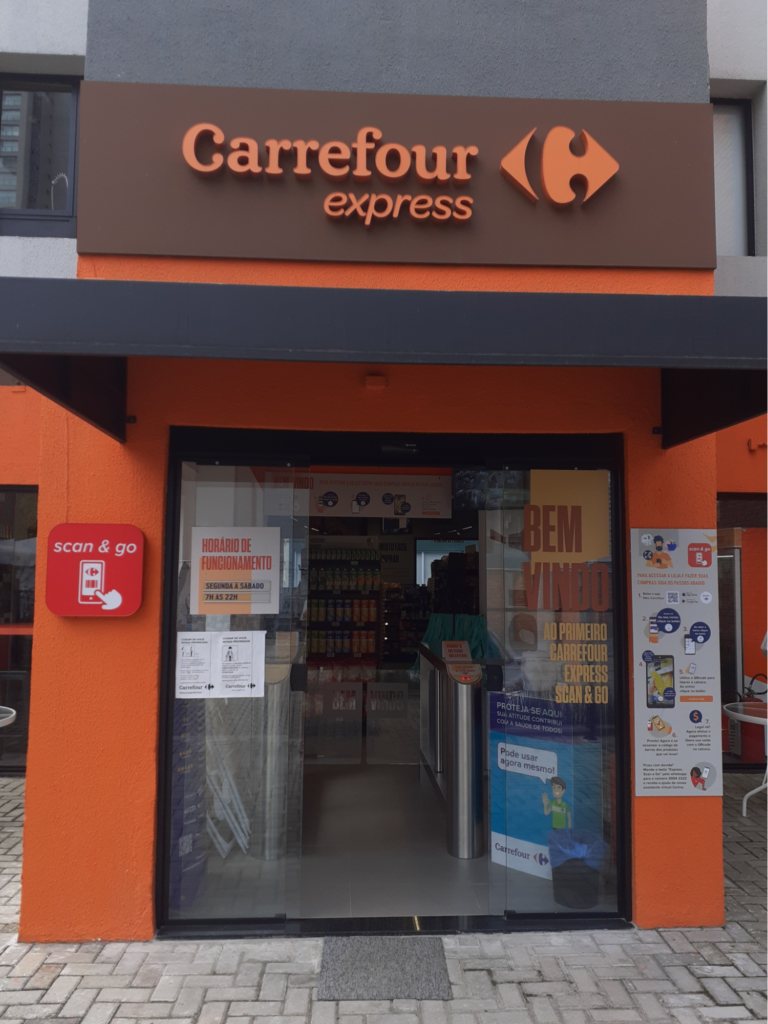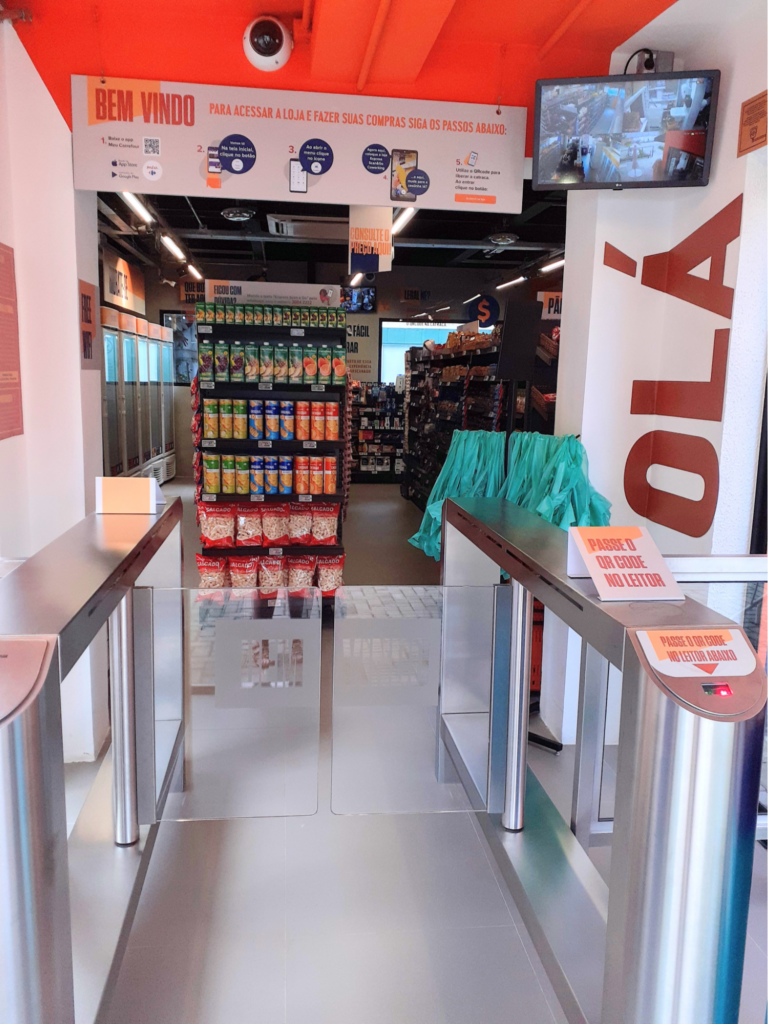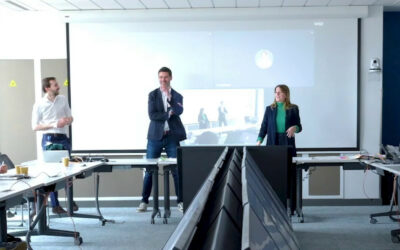Innovation is key for Carrefour Brazil, whether it is developing new concepts, finding new ways to answer to customer needs or just thinking about disruptive solutions.
In this article, we will speak about the successful launch of our first autonomous stores in Brazil.
Carrefour Brazil: An attitude of purposeful innovation and customer centricity
Innovation + customer centricity
The current mindset of Carrefour Brazil’s teams includes everything except “innovating for innovation’s sake”. We believe that innovation must help us to make the life of our customers simpler. When we propose a new concept, whether it is a new app functionality, a new way of doing things or an evolution of our internal processes, we focus first on what customers’ need: Understanding them, their needs and the pain points they may encounter enables us to propose better solutions.
Let us illustrate with an example. Not so long ago, our customers encountered significant issues while ordering online. Limitations were very concrete, for instance the fact of not being able to finalize large baskets (70+ items), a complex navigation (it was difficult for our customers to add products to the chart) or web performance issues (Speed Index of 4,9 seconds on the previous platform vs. 1,3 seconds today). Based on this, we are working extra hard to implement a modern and robust e-commerce platform for food, non-food and as well as a marketplace including 3rd party assortment. Partnering with leading tech companies like Vtex or Mirakl, we managed to deliver a brand new site in only seven months, to launch our “SuperApp” -bundled with a modern loyalty program- or to rethink our physical stores to enable preparation of e-commerce orders. All this allows us to offer superior comfort and a higher level of service to the people that decide to shop online in Carrefour Brazil.
It is important to realize that, under this model, customers’ needs drive tech modernization, and not the other way round (as a matter of fact, we still have some legacy tools that are working fine, and we do not plan to replace them in the short term). This is “purposeful” innovation, or innovation with a clear purpose of customer service.
Under the purposeful innovation framework, we made a habit of constantly monitoring our NPS, parsing social media customer verbatims with great care and being ultra open to accept -and respond to- any kind of suggestions customers can have for us. All this so we can improve every day and to be as close to our customers as possible.
In addition to being able to “sense and respond” very fast, we incorporate customer feedback and suggestions into our innovation funnel, feeding our transformational process. To illustrate this point, I would like to share a recent case in which a specific group of customers made it very clear that our onboarding and sign-in process was too long. In fact, they complained about the quantity of personal information requested (11 fields!) but also about the confirmation sequence where we were using an email to close the process. An in-depth field study at one of our stores helped us to redesign the whole sign-in journey, making it much simpler for first timers.
This mindset really stimulates our creativity, driving our team towards a constant search for the best customer-oriented solutions. It is an extraordinary source of motivation for our team!
The launch of our first autonomous stores
A new business opportunity
Back to autonomous stores. Let us start with customers. They will do anything they can to save queuing time: Surveys show that 86% of customers avoid entering into a store with long check-out lines, swifting to a competitor’s with shorter lines. On the other hand, check-out and payment mechanisms are subject to a major revolution: Research forecasts that payments at frictionless stores will grow from ~$253 million in 2018 to ~$45 billion by 2023.
As a major international retailer, it is our responsibility to provide solutions to reduce queuing time. One of the things we are exploring is leveraging tech to make it happen. Today, multiple tech solutions exist -with pros and cons- and are being piloted at Carrefour, whether it is the 100% SCO (Self Check-Out) store in Romania, Scan&Go mobile techs like ScanLib by Phone in France, i-Carrefour unmanned store in Taiwan or even frictionless containers under study.
Rooted in test & learn, we take advantage of our multi-country footprint when it comes to trying out different solutions in multiple geographical and cultural contexts. The autonomous stores pilots presented in this article are an example of what we are testing in Brazil.
As previously mentioned, our aim is to solve customer issues, quickly and efficiently, we found out that Carrefour Brazil store customers wanted three things:
- Product transparency. Customers wish to explore possible purchases online or using their smartphones before buying.
- Less routine activities. Customers are looking to spend less time on specific parts of their shopping journeys such as queuing at the cash register.
- Convenience. The store needs to be close to our customers so they can shop for essentials on the way back home or going to work.
This is constantly emphasized during customer research performed by our innovation team.
“I like Carrefour’s e-commerce site because it helps me find what I need, with excellent options, brands and prices”,
customer from Carrefour Express Paineiras.
“In order to speed up things, reduce physical contact and offer greater flexibility, all stores should propose some kind of automated journey for the ones that want it”,
customer from Carrefour Express Sirio e Libanes Hospital.
“I have nothing more to say except that I like to shop at Carrefour because it is close to home and I always find what I need!”,
customer from Carrefour Express Shopping West Plaza.
In addition to answering to the aforementioned customer needs, the autonomous stores help us to optimize our operational model. With this new concept, we can provide a customized portfolio of products for urban customers, depending on the localization of the store, as well as a low-cost operation enabling a higher return on investment.
And this new business opportunity is endless! First, Brazil is a continental country with 212 million people growing (+0,7%, 2020) a dynamic GDP (+2,6% expected in 2021). In this context, and significantly boosted by the recent Covid-19 crisis, Brazilians are massively turning to e-commerce. However, with more than 30% of the population not accessing the Internet, stores also have a critical role to play.
Second, Carrefour has developed a particularly rich business environment in Brazil. Besides e-commerce and stores, we have participated in the development of modern start-ups like Ewally (digital financial services), we can offer powerful and modern financial services and we have the chance to have with us the cash & carry powerhouse Atacadão. And all this will be further expanded with the acquisition of Grupo Big. All in all, this ecosystem gives us the opportunity to offer a wide range of services. In the case of our autonomous store, this means that we could include financial services in the store like Alibaba does, or we could also create specialized B2B services in the store leveraging Atacadao.
CoW and Domo
In November last year we proudly opened our autonomous pilot store (Lab Store) at CoWorking (a startup hub). It is with no surprise that we decided to name our store “CoW”. With about 58 square meters, CoW offers ~800 products, specifically selected for a young urban audience.
The adventure did not stop there. At the end of December, when many were getting ready for New Year’s Eve, we opened our second autonomous store in a residential condominium. “Domo” is placed in a residential condominium (~1,000 families) in a city near São Paulo. This 43 square meter store has an assortment of ~750 products fit for families.
How did we manage to provide a 100% digital in-store experience? Rather than investing millions on a new revolutionary convenience concept, our goal was to understand if we could deliver an autonomous store experience, while keeping it “no frills” and extremely efficient. We do this combining multiple technologies:
- A Scan&Go system. As its name suggests, Scan&Go enables our customers to autonomously scan products and pay for them without having to go through a traditional check-out and payment process. We capitalized on our previous experience with Scan&Go in ~40 Express stores, for which customers still had to present themselves to a cashier and provide proof that they paid showing them the ticket. However, the Cow and Domo autonomous stores work fully standalone with Scan&Go, including an automated control of entry and exit.
- The SuperApp. Early November last year we officially launched the “Meu Carrefour” SuperApp. This mobile app provides great set of loyalty features (e.g., custom challenges to earn coins exchangeable for prizes in our stores or with partners), personalized offers, product samples, care (e.g., post-order assistant) and also powerful in-store functionalities (e.g., store locator, offers near me). A few weeks after that, we added the Scan&Go functionality within the SuperApp.
- Electronic Shelf Labels (ESLs) at CoW. They provide real-time product information, dynamic pricing and ops insights such as the minimal stock, the replenishment day or the average sales.
- Digital Out Of Home (DOOH). Digital signage to showcase products, promos and information.
A mobile-first in-store user experience
We aimed at developing a simple, easy-to-use and practical journey with the fewest steps possible for our customers.
First, our customers download -using their cellular network or the free Wi-Fi available in the store- and create an account in the SuperApp. If they already have an online ID registered in https://www.carrefour.com.br/, they can simply log-in using the same omnichannel access data.
With the app on the cellphone, they simply hit on the “Scan&Go” functionality and approach the QR code displayed to the store’s turnstile.
The app is then prepared to scan the EANs of the price tag or the article’s barcode.
Once customers are done and before leaving the store, they simply pay with their credit card registered within the app. They exit the store using a new QR code, which opens the door. The customers receive a detailed invoice by email.
Pretty cool, right? 😉
Here are our first results!
While we are in the ramp up phase, improving our digital product, it is good to see first positive outcomes after a few months. At launch, customers bought small quantities: one or two items. Today, our average basket includes 4,5 items. The frequency is developing nicely too: we now have an average of 119 tickets per day.
We are gradually enhancing the overall in-store user experience thanks to the systematic collection and analysis of customer and employee feedback. For example, we realized that customers needed to open the freezer’s doors to scan the products’ barcodes, which was difficult with their mobile phone in hand. A customer told us that we should display the barcodes and put them on the freezer’s doors. We acted quickly and now customers can directly scan the barcodes without opening the freezers.
And it is not all about the digital journey: The concept itself is evolving to provide the best experience. For instance, since the launch, the assortment has been adjusted with variations even depending on the day of the week – since some products are more successful during weekends for example.
“As my daughter is working from home, and she does not have time to prepare lunch, the store is very handy as she does not have to get her car to buy something to eat and she can grab a few things to eat in a matter of seconds”.
Said Carla, one of our customers.
Fernando, another customer, mentioned, “The App is very cool and the store is really nice”.
Our store staff also responded enthusiastically. Nilsa, who works at the Cow store, noted, “I am glad to be part of it and learn more about this new operation. We have more time to take care of the store as the customers help themselves”.
“[It is] very innovative and very important for the company’s future. Most of the customers love it!”
Adds Rose, who works at the Domo store.
For me, the best testimony was on the inauguration day when a customer, in her seventies, came to me and said: “Is it open? What do I have to do?” I taught her how to download the App and perform the first steps. She then entered the store, bought a few things, paid and then asked me “Is that all?” and I said “Yes” and then she answered back “I can’t wait to tell my grandson that I did all this by myself!”. A true reward after all the hard work.
What’s next
After two successful launches, we are moving forward. This year we plan to open around 20 new autonomous stores. And we will keep innovating since we will use containers as stores!
We are also working on the possibility of packaging the software and operation support (product supply and logistics) to enable a franchising model.
Reaching a better integration of our e-commerce with the autonomous stores is another important line of work, so we can provide a larger product portfolio and use our stores as a pick-up point for the products that we do not carry physically in that store.
And finally, we are continuously improving the solution itself, in particular working on a “Scan&Go 2.0”.
Thanks to customer feedback we are giving small steps to reinvent the future of retail with purposeful innovation!
Don’t forget to check our other articles related to digital in-store.









